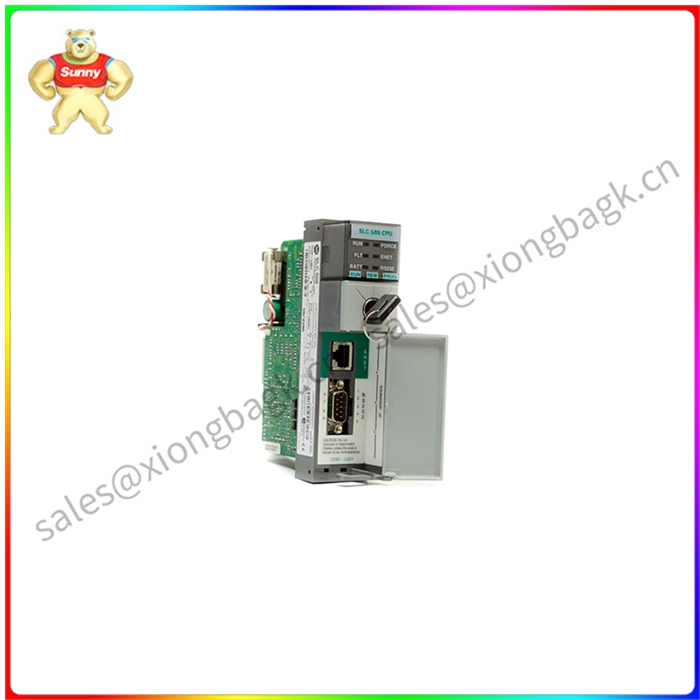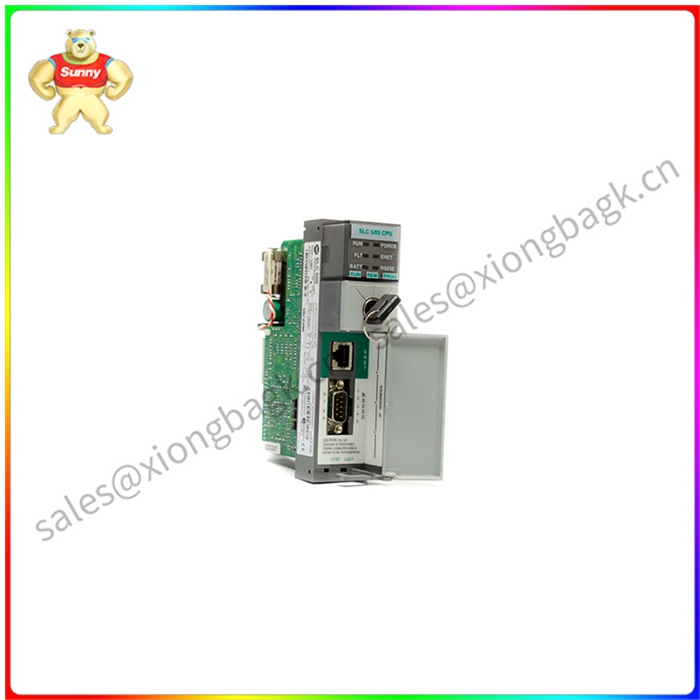1747-L551 高性能控制器
Allen-Bradley 1747-L551 Processor Hardware与程序内存大小集成为16 KB。它是高性能控制器,能够控制多达 4096 个输入和输出点。该模块支持运行时编辑等在线和离线编程。Allen-Bradley 1747-L551 具有通道间、远程 I/O 和 DeviceNet 直通功能。该模块还具有内置的实时时钟和日历。该模块带有用于网络连接的以太网端口和用于点对点通信的 RS232 端口。RS-232 信道支持 DF1 全双工、DF1 半双工主站和 DF1 无线电调制解调器。集成以太网端口支持内置的 10/100 Base-T 以太网通道,以支持 SNMP、BOOTP、扩展消息传递功能和高速通信。对于编程,它包括高 级数学指令和各种附加指令。它还包括对间接寻址的支持。SLC 505 的典型每个关键字程序扫描时间为 0.9 毫秒,典型 I/O 扫描时间为 0.225 毫秒。
该模块具有 150 伏交流电的介电耐受性,符合 UL 508、CSA C22.2 No. 142 标准。1747-L551 的工作振动为 2.5G,频率为 5 至 2000 赫兹。非工作振动为 5 至 2000 赫兹的 5G。该模块的通信电路之间的隔离约为 500 伏直流电。该模块的背板和 I/O 之间的隔离度为 1500 伏交流电。在安装和卸载 I/O 设备之前,请断开控制器和为 I/O 设备提供服务的其他电源的电源。1747-L551 的工作温度为 32 至 140 华氏度,储存温度约为 -40 至 185 华氏度。Allen-Bradley 1747-L551 的工作冲击为 30G(3 个脉冲,11 毫秒)。非工作冲击为 50G(3 个脉冲,11 毫秒)。相对湿度为5-95%,无冷凝。该模块的扫描时间通常约为 0.9 毫秒/K。它的 LED 灯将指示几种不同的情况,包括模块运行时、CPU 出现故障时、电池电量低时、强制执行 I/O 时或其以太网/RS-232 端口处于活动状态时。
此处理器专门安装在 SLC 500 机箱的插槽零 (0) 中。它支持远程 I/O 实现,使用安装在 CPU 所在的机箱上的通信适配器,以及安装在描述远程 I/O 模块的机箱上的扫描器模块。支持的通信协议包括以太网、远程 I/O (RIO)、DH485 和 Data Highway Plus (DH+)。必须明确的是,远程 I/O 技术不同于远程 I/O (RIO) 协议。远程 I/) 技术(有时称为分布式 I/O)是一种技术,它允许通过远程机箱将输入和输出模块安装在远离处理器的地方,而 CPU 仍将远程模块视为本地机箱的一部分。远程 I/O 或通常称为 RIO 是 Allen-Bradley 的专有协议。
与其他处理器类似,该处理器的设计能够与基于计算机的控制系统进行通信,例如人机界面 (HMI) 和监控和数据采集 (SCADA)。

1747-L551 高性能控制器
Allen-Bradley 1747-L551 Processor Hardware integrated with program memory size is 16 KB. It is a high performance controller capable of controlling up to 4096 input and output points. The module supports both online and offline programming such as runtime editing. Allen-Bradley 1747-L551 features inter-channel, remote I/O, and DeviceNet pass-through capabilities. The module also has a built-in real-time clock and calendar. The module comes with an Ethernet port for network connectivity and an RS232 port for point-to-point communication. The RS-232 channel supports DF1 full duplex, DF1 half-duplex master, and DF1 radio modems. The Integrated Ethernet port supports a built-in 10/100 Base-T Ethernet channel to support SNMP, BOOTP, extended messaging capabilities, and high-speed communication. For programming, it includes advanced mathematical instructions and various additional instructions. It also includes support for indirect addressing. The SLC 505 has a typical per-keyword program scan time of 0.9 ms and a typical I/O scan time of 0.225 ms.
The module has dielectric resistance of 150 volts AC and complies with UL 508 and CSA C22.2 No. 142 standards. The 1747-L551 operates with a vibration of 2.5G and a frequency of 5 to 2000 Hz. The non-operating vibration is 5 to 2000 Hz for 5G. The isolation between the communication circuits of the module is about 500 volts of direct current. The isolation between the backplane of the module and the I/O is 1500 volts AC. Before installing and uninstalling I/O devices, disconnect the controller and other power supplies that service the I/O devices. The 1747-L551 operates at 32 to 140 degrees Fahrenheit and is stored at about -40 to 185 degrees Fahrenheit. The Allen-Bradley 1747-L551 has an operating shock of 30G (3 pulses, 11 milliseconds). The non-operating shock is 50G (3 pulses, 11ms). The relative humidity is 5-95% without condensation. The scan time of this module is usually about 0.9 ms /K. Its LED lights will indicate several different situations, including when the module is running, when the CPU is failing, when the battery is low, when I/O is being forced, or when its Ethernet /RS-232 port is active.
This processor is specifically installed in slot zero (0) of the SLC 500 chassis. It supports remote I/O implementations, using a communication adapter installed in the chassis where the CPU is located, and a scanner module installed in the chassis describing the remote I/O module. Supported communication protocols include Ethernet, Remote I/O (RIO), DH485, and Data Highway Plus (DH+). To be clear, remote I/O technology is different from the Remote I/O (RIO) protocol. Remote I/ technology (sometimes referred to as distributed I/O) is a technique that allows input and output modules to be installed away from the processor via a remote chassis, while the CPU still treats the remote module as part of the local chassis. Remote I/O, or RIO as it is commonly called, is a proprietary protocol of Allen-Bradley.
Similar to other processors, the processor is designed to communicate with computer-based control systems, such as the Human Machine Interface (HMI) and monitoring and Data acquisition (SCADA).






 QQ在线客服
QQ在线客服